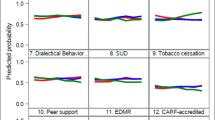Abstract
The authors examined racial matching between case manager and client for 677 seriously mentally ill consumers served through a rural community mental health center in the southeastern United States. Nonparametric statistics indicated that client-case manager dyads were more likely to be of the same race than of different races. Same-race dyads tended to have greater service utilization as indicated by a greater number of made appointments over the study period. An interaction was found for failed appointments where African Americans in same-race dyads were more likely to fail appointments, while caucasian consumers in same-race dyads were less likely to fail appointments.
Similar content being viewed by others
References
Banks, W. (1972). The Black client and the helping professional. In R. Jones (Ed.)Black Psychology. New York: Harper & Row.
Butler, R.O. (1975). Psychotherapy: Implications of a Black-consciousness process model.Psychotherapy: Theory, Research, and Practice, 12, 407–411.
Comas-Diaz, L., & Griffith, E.E. (Eds.) (1988).Clinical guidelines in cross-cultural mental health. New York: Wiley.
Cross, T.L., Bazron, B.J., Dennis, K.W., & Isaacs, M.R. (1992).Towards a culturally competent system of care. Washington, D.C.: CASSP Technical Assistance Center.
Cross, W.E., Jr. (1971). The Negro-to-Black conversion experience: Toward a psychology of Black liberation.Black World, 20(9), 13–27.
Cross, W.E., Jr. (1978). Models of psychological nigrescence: A literature review.Journal of Black Psychology, 5(1), 13–31.
DeLeon, P.H., Wakefield, M., Schultz, A.J., Williams, J., and VandenBos, G.R. (1989). Rural America: Unique opportunities for health care delivery and health services research.American Psychologist, 44(10), 1298–1306.
Fitchen, J.M. (1981)Poverty in Rural America: A case study Boulder, Colorado: Westview Press.
Flaskerud, J.H., & Hu, L. (1992). Relationship of Ethnicity to Psychiatric Diagnosis.Journal of Nervous and Mental Disease, 180(5), 296–303.
Helms, J.E. (1986). Expanding racial identity theory to cover the counseling process.Journal of Counseling Psychology, 33(1), 62–64.
Helms, J.E. (1990).Black and White Racial Identity: Theory, Research, and Practice. Westport, Connecticut: Greenwood Press.
Human, J., & Wasem, C. (1991). Rural mental health in America.American Psychologist, 46(3), 232–239.
Jenkins, A.H. (1985). Attending to self-activity in the Afro-American client.Psychotherapy, 22, 335–341.
Jones, E.E. (1978). Effects of race on psychotherapy process and outcome: An exploratory investigation.Psychotherapy: Theory, Research, and Practice, 15, 226–236.
Jones, E.E. (1982). Psychotherapists' impressions of treatment outcome as a function of race.Journal of Consulting and Clinical Psychology, 38, 722–731.
Jones, E.E., & Thorne, A. (1987). Rediscovery of the subject: Intercultural approaches to clinical assessment.Journal of Consulting and Clinical Psychology, 55, 488–496.
Kleiner, R., Tuckman, J., & Lovell, M. (1960). Mental disorder and status based on race.Psychiatry, 23, 271–27.
Knesper, D.J., Wheeler, J.R.C. & Pagnucco, D.J. (1984). Mental health services providers' distribution across counties in the United States.american Psychologist, 39(12), 1424–1434.
Milliones, J.M. (1980). Construction of a Black consciousness measure: Psychotherapeutic implications.Psychotherapy: Theory, Research, and Practice, 17(2), 175–182.
O'Sullivan, M.J., Peterson, P.D., Cox, G.B., & Kirkeby, J. (1989). Ethnic populations: Community mental health services ten years later.American Journal of Community Psychology, 17, 17–30.
Orlandi, M.A., Weston, R., & Epstein, L.G. (1992).Cultural Competence for Evaluators: A Guide for Alcohol and Other Drug Abuse Prevention Practitioners working with Ethnic/Racial Communities. Washington, D.C.: U.S. Government Printing Office.
Padilla, A.M., & Salgado De Snyder, N. (1985). Counseling Hispanics: Strategies for effective intervention. In P. Pederson (Ed.),Handbook of cross-cultural counseling and therapy. Westport, Connecticut: Greenwood Press.
President's Commission on Mental Health (1978).Report to the President. Washington, D.C.: U.S. Government Printing Office.
Rodgers, H.R., & Weiher, G. (1989).Rural Poverty: Special causes and policy reforms. Westport, Connecticut: Greenwood Publishing. Inc.
Rowland, D. & Lyons, B. (1989). Triple jeopardy: Rural, poor, and uninsured.Health Services Research, 23(6), 976–1004.
Schofield, W. (1964).Psychotherapy: The purchase of friendship. Englewood Cliffs, NJ: Prentice-Hall.
Snowden, L.R., & Cheung, F.K. (1990). Use of inpatient mental health services by members of ethnic minority groups.American Psychologist, 45, 347–355.
Solomon, P. (1987). Racial factors in mental health service utilization.Psychosocial Rehabilitation Journal, 11(3), 3–12.
Sue, S. (1977). Community mental health services to minority groups: Some optimism, some pessimism.American Psychologist, 32, 616–624.
Sue, S. (1988). Psychotherapeutic services for ethnic minorities: Two decades of research findings.American Psychologist, 43, 301–308.
Sue, S. (1992). Ethnicity and mental health: Research and policy issues.Journal of Social Issues, 48(2), 187–205.
Taylor, R.J., & Chatters, L.M. (1989). Family, friend and church networks of Black Americans. In R.L. Jones (Ed.),Black adult development and aging. Berkeley: Cobb and Henry Publishers.
Taylor, R.J., Chatters, L.M., Tucker, M.B., & Lewis, E. (1990). Developments in research on black families: A decade review.Journal of Marriage and the Family, 37, 298–304.
Vontress, C.E. (1970). Counseling blacks.Personnel and Guidance Journal, 48, 713–719.
Wagenfeld, M.O., Murray, J.D., Mohatt, D., & DeBruyn, J.C. (1993).Mental Health and American: An Overview. National Rural Health Association.
Wan, T.T.H., & Ozcan, Y.A. (1991). Determinants of Psychiatric Rehospitalization: A social area analysis.Community Mental Health Journal, 27(1), 3–16.
Wu, I.H., & Windle, C. (1980). Ethnic specificity in the relative minority use and staffing of community mental health centers.Community Mental Health Journal, 16, 156–168.
Yamamoto, J., James, Q.C., & Palley, N. (1968). Cultural Problems in psychiatric history.Archives of General Psychiatry, 19, 45–49.
Author information
Authors and Affiliations
Rights and permissions
About this article
Cite this article
Blank, M.B., Tetrick, F.L., Brinkley, D.F. et al. Racial matching and service utilization among seriously mentally Ill consumers in the rural south. Community Ment Health J 30, 271–281 (1994). https://doi.org/10.1007/BF02188887
Issue Date:
DOI: https://doi.org/10.1007/BF02188887




